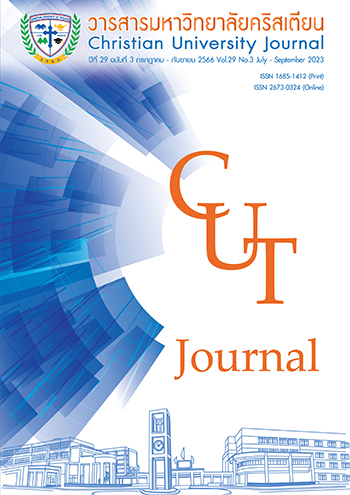การเปรียบเทียบความแข็งแรงกล้ามเนื้อหายใจและลิ้น ในผู้ที่มีภาวะนอนกรนธรรมดาและ ผู้ที่มีภาวะหยุดหายใจขณะหลับจากการอุดกั้นในระดับรุนแรง
คำสำคัญ:
ความแข็งแรงกล้ามเนื้อลิ้น, ความแข็งแรงกล้ามเนื้อหายใจ, ภาวะหยุดหายใจขณะหลับจากการอุดกั้นในระดับรุนแรง, ภาวะนอนกรนธรรมดาบทคัดย่อ
วัตถุประสงค์งานวิจัยครั้งนี้ เพื่อเปรียบเทียบความแข็งแรงของกล้ามเนื้อหายใจเข้าและออก และกล้ามเนื้อลิ้น ในผู้ที่มีภาวะนอนกรนธรรมดา และผู้ที่มีภาวะหยุดหายใจขณะหลับจากการอุดกั้นในระดับรุนแรง ผู้เข้าร่วมงานวิจัยเป็นผู้ที่มีภาวะนอนกรนธรรมดาหรือมีภาวะหยุดหายใจขณะหลับจากการอุดกั้นในระดับรุนแรงที่มีอายุ 18-70 ปี ดัชนีมวลกาย < 30 กิโลกรัม/ตารางเมตร โดยผู้เข้าร่วมงานวิจัยทั้งหมด 2 กลุ่ม กลุ่มละ 41 คน ได้รับการประเมินความแข็งแรงของกล้ามเนื้อหายใจเข้า (Maximum inspiratory pressure: MIP) ความแข็งแรงของกล้ามเนื้อหายใจออก (Maximum expiratory pressure: MEP) และความแข็งแรงของลิ้นด้านหน้า (Anterior maximum isometric tongue presses: AMAX) และลิ้นทางด้านหลัง (Posterior maximum isometric tongue presses: PMAX) โดยใช้สถิติ Independent sample t-test และ Mann-Whitney U test เพื่อเปรียบเทียบตัวแปรระหว่างกลุ่ม
ผลการศึกษาพบว่า ไม่มีความแตกต่างกันอย่างมีนัยสำคัญทางสถิติของความแข็งแรงของกล้ามเนื้อลิ้นทางด้านหน้าระหว่างกลุ่มผู้ที่มีภาวะหยุดหายใจขณะหลับจากการอุดกั้นในระดับรุนแรงและกลุ่มผู้ที่มีภาวะนอนกรนธรรมดา (p = 0.33) อย่างไรก็ตามพบแตกต่างกันอย่างมีนัยสำคัญทางสถิติระหว่างกลุ่มของความแข็งแรงของกล้ามเนื้อลิ้นทางด้านหลัง (p = 0.03) และความแข็งแรงของกล้ามเนื้อหายใจเข้าและออกในผู้ที่มีภาวะหยุดหายใจขณะหลับจากการอุดกั้นในระดับรุนแรงมากกว่าอย่างมีนัยสำคัญเมื่อเทียบกับผู้ที่มีภาวะนอนกรนธรรมดา (p = 0.03, p = 0.006) สรุปผล ผู้ที่มีภาวะหยุดหายใจขณะหลับจากการอุดกั้นในระดับรุนแรงมีความแข็งแรงของกล้ามเนื้อลิ้นส่วนหลังน้อยกว่า แต่ความแข็งแรงกล้ามเนื้อหายใจเข้ามากกว่าเมื่อเทียบกับผู้ที่มีภาวะนอนกรนธรรมดา
เอกสารอ้างอิง
Adams V, Mathisen B, Baines S, Lazarus C, & Callister R. (2014). Reliability of measurements of tongue and hand strength and endurance using the Iowa Oral Performance Instrument with healthy adults. Dysphagia, 29(1), 83-95. doi: 10.1007/s00455-013-9486-5.
Banno K, & Kryger M H. (2007). Sleep apnea: clinical investigations in humans. Sleep Med, 8(4), 400-426. doi: 10.1016/j.sleep.2007.03.003.
Birk R, Stuck B A, Maurer J T, Schell A, Muller C E, Kramer B, et al. (2021). Maximum isometric tongue force in patients with obstructive sleep apnoea. Eur Arch Otorhinolaryngol, 278(3), 893-900. doi: 10.1007/s00405-020-06327-7.
Camacho M, Guilleminault C, Wei J M, Song S A, Noller M W, Reckley L K, et al. (2018). Oropharyngeal and tongue exercises (myofunctional therapy) for snoring: A systematic review and meta-analysis. Eur Arch Otorhinolaryngol, 275(4), 849-855. doi: 10.1007/ s00405-017-4848-5.
Cazan D, Mehrmann U, Wenzel A, & Maurer J T. (2017). The effect on snoring of using a pillow to change the head position. Sleep Breath, 21(3), 615-621. doi: 10.1007/s11325-017-1461-1.
Celli B R. (1986). Respiratory muscle function. Clin Chest Med, 7(4), 567-584.
Davies R J, Ali N J, & Stradling J R. (1992). Neck circumference and other clinical features in the diagnosis of the obstructive sleep apnoea syndrome. Thorax, 47(2), 101-105. doi: 10.1136/thx.47.2.101.
De Felicio C M, Da Silva Dias F V, & Trawitzki L V V. (2018). Obstructive sleep apnea: Focus on myofunctional therapy. Nat Sci Sleep, 10, 271-286. doi: 10.2147/NSS.S141132.
Granton T, Naughton T, Benard C, Liu P, Goldstein S, & Bradley D. (1996). CPAP improves inspiratory muscle strength in patients with heart failure and central sleep apnea. Am J Respir Crit Care Med, 153(1), 277-282. doi: 10.1164/ajrccm.153.1.8542129.
Kapur V K. (2010). Obstructive sleep apnea: diagnosis, epidemiology, and economics. Respir Care, 55(9), 1155-1167.
Kim E, Park S, Park H, Shin J, Ha Y, Park J, et al. (2015). Predictors for presence and severity of obstructive sleep apnea in snoring patients: Significance of neck circumference. J Sleep Med, 12(2), 34-38.
Mediano O, Romero-Peralta S, Resano P, Cano-Pumarega I, Sanchez-de-la-Torre M, Castillo-Garcia M, et al. (2019). Obstructive sleep apnea: emerging treatments targeting the genioglossus muscle. J Clin Med, 8(10), 1-18. doi: 10.3390/jcm8101754.
Nobrega-Junior J C N, Dornelas de Andrade A, Andrade E A M, Andrade M D A, Ribeiro A. S V, Pedrosa R P, et al. (2020). Inspiratory muscle training in the severity of obstructive sleep apnea, sleep quality and excessive daytime sleepiness: A placebo-controlled, randomized trial. Nat Sci Sleep, 12, 1105-1113. doi: 10.2147/NSS.S269360.
Noordzij M, Dekker W, Zoccali C, & Jager J. (2011). Sample size calculations. Nephron Clin Pract, 118(4), c319-323. doi: 10.1159/000322830.
Perry J L, Kuehn D P, & Sutton B P. (2013). Morphology of the levator veli palatini muscle using magnetic resonance imaging. Cleft Palate Craniofac J, 50(1), 64-75. doi: 10.1597/11-125.
Ramsook A H, Molgat-Seon Y, Schaeffer M R, Wilkie S S, Camp P G, Reid W D, et al. (2017). Effects of inspiratory muscle training on respiratory muscle electromyography and dyspnea during exercise in healthy men. J Appl Physiol, 122(5), 1267-1275. doi: 10.1152/japplphysiol.00046.2017.
Reggiani C, & Schiaffino S. (2020). Muscle hypertrophy and muscle strength: Dependent or independent variables? A provocative review. Eur J Transl Myol, 30(3), 9311. doi: 10.4081/ejtm.2020.9311.
Selim B, & Ramar K. (2021). Sleep-related breathing disorders: When CPAP is not enough. Neurotherapeutics, 18(1), 81-90. doi: 10.1007/s13311-020-00955-x.
Singh B, Yadollahi A, Lyons O, Alshaer H, & Bradley T D. (2017). The effect of sitting and calf activity on leg fluid and snoring. Respir Physiol Neurobiol, 240, 1-7. doi: 10.1016/ j.resp.2017.02.008.
Tiffany McCausland B B. (2021). Anatomy, Head and neck, Genioglossus muscle. Treasure Island (FL): StatPearls Publishing.
Yano J, Yamamoto-Shimizu S, Yokoyama T, Kumakura I, Hanayama K, & Tsubahara A. (2019). Effects of anterior tongue strengthening exercises on posterior tongue strength in healthy young adults. Arch Oral Biol, 98, 238-242. doi: 10.1016/j.archoralbio.2018.11.028.
ดาวน์โหลด
เผยแพร่แล้ว
ฉบับ
ประเภทบทความ
สัญญาอนุญาต
ลิขสิทธิ์ (c) 2023 มหาวิทยาลัยคริสเตียน

อนุญาตภายใต้เงื่อนไข Creative Commons Attribution-NonCommercial-NoDerivatives 4.0 International License.



